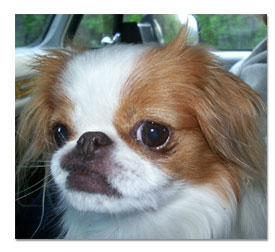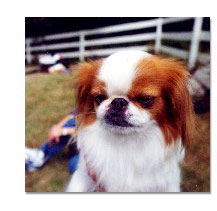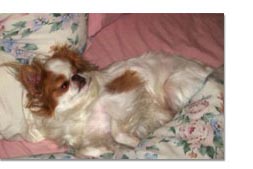 |
|
|
 |
 |
 |
Breed Profile
--Written by Janet Legg

 Breed: Breed:
Japanese Chin
Owner Level:
Committed novice dog owners would love the Japanese Chin. No serious dog experience required.
Average Life Span:
10-12 years average, but known to live up to 15
Average Weight:
5-10 pounds
Height:
8 to 11" tall
Color And Coat:
Coat is typically long and silky with feathers and pantaloons. Fluffy longer coat hangs off the ears, tail and back legs. Colors are either black and white, red and white, or black and white with tan points. The tan points shall include tan or red spots over each eye, inside the ears, on both cheeks. Red shall include all shades of red, orange, and lemon, as well as sable.
Typical Health Problems:
Luxating patellas, cataracts, and early-onset heart murmurs. Approximately 2-5% of all dogs, Chin included, may have epilepsy. Some experience back injuries.
 History and Personality: History and Personality:
The Japanese Chin (previously known as the Japanese Spaniel) is an ancient toy breed, whose earliest history is shrouded in mystery. It is safe to say that the breed that we recognize today was developed in Japan. These toy dogs were highly prized in Japan, they were always kept among the people of noble birth, and occasionally presented to a noted person, a diplomat, or to a foreigner who was in favor with the members of nobility.
The Chin seems to be a blend of cat and dog; a dog with many catlike characteristics. Ask anyone owned by a Chin, and they will tell you incredible tales of climbing and jumping feats, of fastidious cleaning habits, of using their front feet to bat and explore, and of finding their Chin in the most unlikely of spots! This is a sensitive and intelligent dog whose only purpose is to serve man as a companion. The perfect lap dog. They are responsive and affectionate with those it knows and loves, but reserved with strangers or in new situations. 
The Chin is a bright and alert, inquisitive and intelligent little dog. They are impish and delightful dogs who exhibit a wonderful sense of humor. Although they appear similar to the Pekingese, their longer legs allow them to keep up with a normal paced hike. The breed has a quiet little bark and is not known for being "yappy". They also are NOT generally nippy at strangers, but remain aloof until comfortable with new people.
Why are these dogs typically in animal shelters?
These dogs are seldom found in shelters, but occasionally seen. Reasons given are: can't housebreak; moving; allergies; afraid of children. Chin also shed alot. This breed though small will shed all day, every day. No seasonal blow-outs, just a constant stream of white hair on everything.
How do these dogs handle rescue or shelter life?
Although a sweet sensitive breed, the some Chin handle temporary stays in shelters and rescue foster homes very well. In spite of their diminutive size, they do not lack for heart and character. But for the most part Chin do not do well in shelters. Some Chin while in a shelter environment can become terrified very easily and have the potential to seize and/or snap. It's imperative that shelters work quickly to move Chin into safer, calmer areas. Chin do, however, adapt to changes extremely well as long as the change is favorable. Rescue Chin generally do extremely well going from foster to forever homes. They seem to understand what a forever home means and love to let their new people know "I'm here!" They quickly and devotedly bond with new families.

Who should own this breed?
Perfect owners include people who are home a lot; who are gentle and calm by nature rather than loud and harsh or dominant. You would enjoy the Chin if you like to giggle with your pet. Owners must provide a warm lap to climb onto and a snuggly bed for at night. Owners must enjoy the clingy constant companionship of a tiny dog who follows them room-to-room, seeking their lap every time they sit down. The Chin does fine in apartments and condos, and they are perfect for people who do NOT want a yappy-nippy small dog. If you like drawing attention to yourself, carry a Japanese Chin around in pubic.
Is this breed good with children?
Not preferred for families with young children due to the breed's diminutive size and potential for accidental injury. Some of the Chin are child-friendly, and some are not.

How easy is training and house training with this breed?
Although the breed is bright and intelligent, then can be a little stubborn in training. They can be housebroken, but owners must be diligent in letting their tiny dogs (with tiny tanks) outdoors often - or provide an alternative potty spot. They can be cat-box trained. Many Chin have been trained to compete in obedience and agility, as well as taught cute tricks.
Is this breed good with other dogs in general?
Yes, they are good with other dogs but owners must take extra precautions to protect the tiny dog from large-dog rough play or injuries. Off-leash dog areas can be dangerous - even lethal - to the little Chin.

Socializing this breed?
The Chin is often standoffish around strangers, but warms up fairly quickly when allowed to do so on their own. Regular socializing is recommended. |
|

